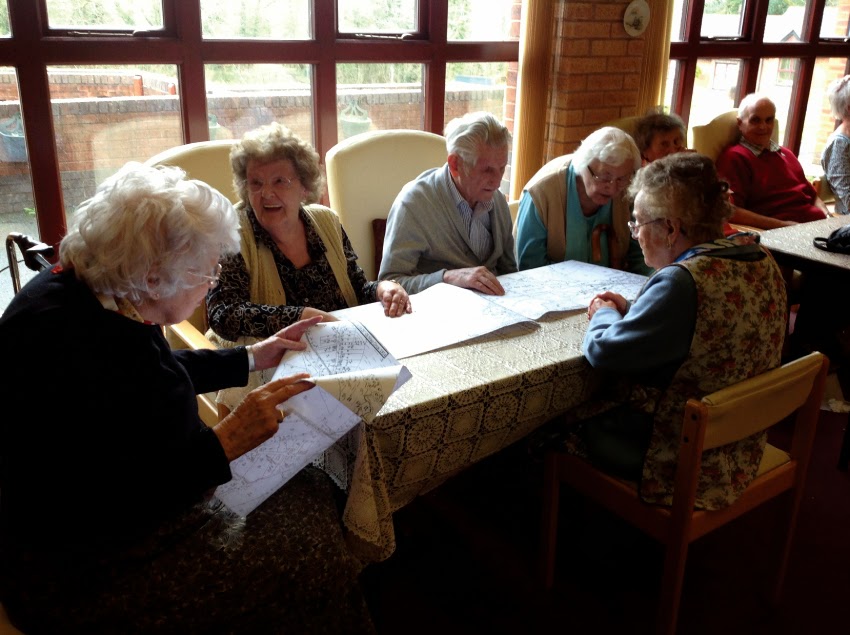On Wednesday 11 June the
Royal Commission and
Addoldai Cymru (Welsh Religious Buildings Trust) held a community history day at
Hen Dŷ Cwrdd Unitarian Chapel (NPRN 8941) in Trecynon, Aberdare. The aim of the day was to gather memories, including photographs and documents, relating to the history of the chapel.
Hen Dŷ Cwrdd, established at Trecynon in 1751, is the oldest Nonconformist place of worship in the Aberdare district. Its origins extend back to the dissenting meeting houses at Cwmyglo and Blaencanaid Farm on the mountainside between Aberdare and Merthyr Tydfil. The chapel was built on land donated by nearby farm, Gadlys-uchaf. At this time the chapel would have been relatively isolated, with the settlement of Trecynon only established after the opening of Aberdare Ironworks in 1800. The original cottage-like meeting house was demolished and replaced by the present chapel in 1862. Its design, by Evan Griffiths of Aberdare, was intended to be ‘simple and strong, reflecting Unitarian beliefs in liberty, tolerance and forbearance’.
 |
| Hen Dŷ Cwrdd Chapel, constructed in 1862. |
Although its congregation only ever numbered around 80 people, Hen Dŷ Cwrdd played a prominent role in the story of Unitarianism in Wales. From 1811–1833 its minister was the Rev. Thomas Evans (Tomos Glyn Cothi), renowned hymn writer and author of one of Wales’ first English-Welsh dictionaries. He was the first specifically Unitarian minister in Wales and pioneer of radical political, social and religious reform movements. He was reportedly invited to be minister whilst serving a sentence at Carmarthen Jail for composing a song in support of the French Revolution. Underneath the pulpit is a list of all the chapel’s ministers from 1756–1965.
 |
| Register of ministers at Hen Dŷ Cwrdd 1756–1962. |
For over 100 years, Hen Dŷ Cwrdd was the only Unitarian place of worship in the Cynon Valley, until a chapel was opened at Cwmbach in 1859. Members of Hen Dŷ Cwrdd’s congregation included: Rees Hopkin Rhys (known locally as ‘Blind Rhys’, having lost his sight in an explosion at Dowlais Works), who was largely responsible for the development of Aberdare Park and the improvement of water and sewage schemes and other public amenities in the town; William Williams (known locally as Carw Coch), leading figure in the development of the eisteddfod movement and landlord of the Stag Inn, where he held the Carw Coch eisteddfod from 1841; Thomas Dafydd Llywelyn, famous harpist, who brought the newly written song ‘Mae Hen Gwlad Fy Nhadau’ to public notice at the National Eisteddfod in 1858 (before it went on to become the national anthem); Griffith Rhys Jones (known as Caradog), conductor of the South Wales Choral Union, who led them to victory in the 1882 and 1883 Crystal Palace Challenge Cup; and Evan Thomas, who patented important improvements to the Miner’s Safety Lamp in 1887.
Hen Dŷ Cwrdd closed its doors to worshippers in 1995 and has since stood empty. The chapel is now in the care of Addoldai Cymru, which aims to restore the building and bring it back into community use.
 |
| The interior of Hen Dŷ Cwrdd today. |
Working with local communities, The Royal Commission and Addoldai Cymru are developing an interactive virtual museum, which will tell the story of Nonconformity in Wales. Resources are to include the creation of virtual access to chapels in the care of Addoldai Cymru through laser scanning, gigapixel photography and computer visualisation. This will add to Addoldai Cymru’s wider project to create a Faith Trail linking Hen Dŷ Cwrdd and other Unitarian chapels across Wales, including Capel Pen-rhiw (from Dre-fach Felindre, Carmarthenshire, now in St Fagans National History Museum ) and Yr Hen Gapel, Llwynrhydowen (Ceredigion).
The Hen Dŷ Cwrdd community history day was held at the adjacent Mount Pleasant Hotel. We received a steady stream of visitors throughout the afternoon, including Hen Dŷ Cwrdd’s last minister, the Rev. Eric Jones, who brought numerous items to be scanned, including some of the chapel’s historic minute books.
 |
| The Royal Commission’s Helen Rowe chats to a local resident about his memories of the chapel. |
We were also visited by Addoldai Cymru volunteer, Chris King, who has produced hand-drawn measured survey drawings of Hen Dŷ Cwrdd and other chapels in the area, a number of which he brought along to be copied.
 |
| The Royal Commission’s Susan Fielding discussing architectural drawings of the chapel with volunteer, Chris King. |
Royal Commission and Aberystwyth University staff members were on hand to demonstrate survey techniques in the chapel grounds.
 |
| The Royal Commission’s Ross Cook, demonstrating how to survey a building using a total station. |
 |
| Marek Ososinski of Aberystwyth University, explaining the process of laser scanning to the Rev. Eric Jones. |
As part of the project, more community history days are to be held at other chapels during June and July, at:
- Hen Gapel, Llwynrhydowen: 25 June, 2─7pm at Capel Llwynrhydowen, Pontsian, Llandysul, Ceredigion, SA44 4UB.
- Peniel, Tremadog: 10 July, 2─7pm at Capel Peniel, Tremadog, Porthmadog, Gwynedd, LL49 9PS.
- Bethania, Maesteg: 23 July, 2─7pm at Capel Bethania, Bethania Street, Maesteg CF34 9EX.
By: Nikki Vousden
Tanysgrifiwch i Newyddion Treftadaeth Cymru a chofrestrwch ar gyfer yr RSS porthiant llawn: cliciwch y botwm RSS hwn

a
thanysgrifiwch!
Rydym hefyd ar gael ar:



Twitter Hashtag: #RCAHMWales
 a thanysgrifiwch!
a thanysgrifiwch!

























